Have you been suffering from persistent wrist pain that interferes with your daily activities? If you have, then you may be suffering from De Quervain’s, a condition that can severely impact the functionality of your hand and wrist. But don’t worry, because relief and restoration of your hand’s dexterity are within reach, thanks to the expertise of Dr Stuart Kirkham and his dedicated team at the Sydney Orthopaedic Surgeon Clinic.
With over 25 years of experience as an esteemed orthopaedic surgeon, Dr Kirkham takes great pride in offering exceptional care to individuals in the community with various hand and wrist conditions. His comprehensive understanding of De Quervain’s and other related conditions, coupled with his compassionate approach, makes him the ideal partner in your journey towards recovery.
Operating out of five conveniently located clinics, Dr Kirkham offers a wide range of treatment options, with each being tailored to your specific needs. Whether it’s non-surgical interventions like rest, icing, and medications, or more advanced surgical techniques, Dr Kirkham is well-equipped to address your condition and deliver the support you need. Don’t let De Quervain’s stop you from living your life to the fullest. Reach out to our team today and schedule a consultation with Dr Kirkham – together, we’ll develop a personalised plan to get you back to doing the things you love with a pain-free hand. Your journey to a healthier, more functional wrist starts here!
Anatomy
The hand and wrist are among the most intricate anatomy of the body, allowing us to perform a range of delicate movements essential for daily functioning. Composed of many different bones, joints, ligaments, and tendons, these complex structures enable us to grasp, hold, and manipulate objects with precision. Within this complex framework lies the specific anatomy involved in De Quervain’s, a condition affecting the tendons and sheaths near the base of the thumb.
At the heart of De Quervain’s lies the tendons responsible for moving the thumb – the abductor pollicis longus and the extensor pollicis brevis. These tendons work in harmony, allowing the thumb to pivot and move away from the hand, giving us the ability to grip and pinch. However, when these tendons become inflamed or irritated due to overuse or repetitive hand movements, they can lead to De Quervain’s tenosynovitis.
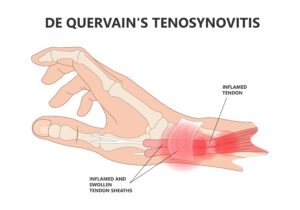
The tendons pass through a narrow tunnel known as the first dorsal compartment, surrounded by protective sheaths that enable smooth gliding of the tendons during motion. When inflammation occurs, these sheaths can thicken and constrict the tendons, resulting in pain, tenderness, and limited thumb movement. The exact cause of De Quervain’s may vary, but certain activities that involve repetitive thumb and wrist movements, such as texting, typing, or gaming, are known to be potential triggers.
Understanding this specific anatomy is essential in grasping the underlying mechanisms of De Quervain’s. Fortunately, Dr Kirkham has in-depth knowledge of all elements of this intricate structure, and this allows him to accurately diagnose and tailor treatments to provide lasting relief. By addressing the root causes of De Quervain’s and developing individualised treatment plans, Dr Kirkham aims to restore optimal hand function and empower his patients to regain control of their lives. Don’t let De Quervain’s hold you back – schedule a consultation with Dr Kirkham today and explore the possibilities of pain-free wrist function today.
Causes and Risk Factors
De Quervain’s tenosynovitis is often associated with overuse or repetitive hand and wrist movements, but it can be triggered by a range of other causes. One of the primary culprits behind this condition is an irritation of the tendons that run along the base of the thumb. When these tendons experience excessive friction and stress due to repetitive activities like grasping, pinching, or twisting motions, they can become inflamed and lead to De Quervain’s tenosynovitis. Tasks that involve excessive use of the thumb, such as gardening, gaming, or even caring for an infant, can contribute to the development of this condition.
In addition, a range of risk factors can also increase an individual’s likelihood of developing De Quervain’s. Occupations or hobbies that require repetitive thumb and wrist movements, like carpentry, knitting, or playing musical instruments, may put individuals at a higher risk. It’s also important to recognise that women are more susceptible to developing this condition, particularly during pregnancy and in the postpartum period where hormonal changes and fluid retention occur. Age can also play a role, with De Quervain’s occurring more frequently in individuals between 30 and 50 years of age.
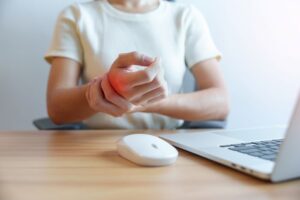
While certain activities and demographic factors can elevate the risk, genetic predisposition and underlying conditions may also contribute to the development of De Quervain’s. Some individuals may have a natural predisposition to inflammatory conditions, making them more susceptible to tendon irritation. Additionally, pre-existing health conditions, such as rheumatoid arthritis, can heighten the risk of developing this condition.
Understanding the primary causes and risk factors of De Quervain’s is crucial in taking proactive steps to prevent its onset or seeking timely medical intervention. Dr Kirkham’s wealth of experience in treating hand and wrist conditions, including De Quervain’s, enables him to accurately identify underlying factors and create personalised treatment plans. Through targeted care and expert guidance, patients can regain control of their hand’s functionality and overcome the limitations imposed by this condition. Don’t let De Quervain’s rule your everyday life – contact Dr Kirkham for a professional evaluation and kickstart your journey towards a pain-free future.
Symptoms and Identification
Recognising the symptoms of De Quervain’s is vital in seeking timely intervention and preventing further complications. Individuals with this condition often experience pain and tenderness along the thumb side of the wrist, which can radiate up the forearm. Swelling and inflammation in the affected area may also be noticeable, and the pain tends to worsen with thumb movement or gripping activities. As De Quervain’s progresses, the functioning of the hand may be compromised, leading to difficulties in performing simple tasks like turning doorknobs, grasping objects, or even using a phone.
Symptoms of De Quervain’s can manifest gradually, with mild discomfort initially that intensifies over time. Left untreated, this condition can significantly impact daily activities, hindering one’s ability to perform tasks that once seemed simple. Early identification is crucial in preventing further aggravation of the tendons and improving the chances of successful treatment.

As an experienced orthopaedic surgeon, Dr Kirkham has the expertise to accurately identify the condition and develop individualised treatment plans tailored to each patient’s unique needs. Through a combination of physical examinations, medical history analysis, and imaging techniques, such as X-rays and MRI scans, he can determine the extent of the tendon irritation and inflammation.
Take the leap of faith and trust Dr Kirkham to deliver a stellar recovery plan if you suspect you may be suffering from De Quervain’s. Dr Kirkham’s dedication to providing personalised care and effective treatment options ensures that patients receive the best possible outcome and regain optimal hand function. Don’t let De Quervain’s interrupt your life any further – take the first step towards relief and restoration by consulting Dr Kirkham and his team at the Sydney Orthopaedic Surgeon Clinic.
Diagnosis and Imaging
Diagnosing De Quervain’s involves a comprehensive approach, starting with initial assessment methods and physical examination. During the physical examination, Dr Kirkham will carefully assess the affected hand and wrist, looking for signs of tenderness, swelling, and limited thumb movement. He may also perform specific tests, such as Finkelstein’s test, in which the patient’s thumb is bent across the palm to check for pain and discomfort in the wrist’s base.
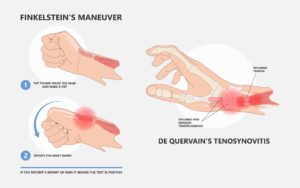
While the physical examination provides valuable insights, imaging techniques play a crucial role in confirming the diagnosis and understanding the extent of the condition. X-rays may be ordered to rule out other potential causes of wrist pain, such as fractures or arthritis. However, since De Quervain’s primarily involves soft tissue, an MRI or ultrasound is often more useful. These imaging techniques can reveal the inflammation and thickening of the tendons and the condition of the sheaths, allowing for a more accurate diagnosis.
This accuracy and clarity in diagnosing De Quervain’s is crucial in determining the most appropriate and effective form of treatment for the patient. Differentiating this condition from other hand and wrist ailments is also vital to avoid unnecessary treatments and ensure targeted interventions. With an accurate diagnosis, Dr Kirkham and his team can design individualised treatment strategies to address the specific nature of De Quervain’s in each patient.
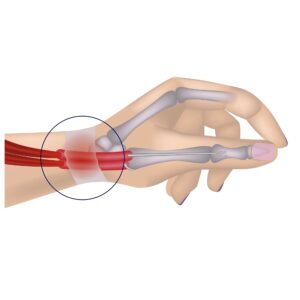
If you suspect you may be experiencing De Quervain’s or are concerned about persistent wrist pain and limited thumb movement, an early and thorough diagnosis is essential. Dr Kirkham and the dedicated team at the Sydney Orthopaedic Surgeon Clinic have vast experience in diagnosing and treating various hand and wrist conditions, including De Quervain’s. His expertise, coupled with advanced diagnostic tools, ensures a precise understanding of your condition, paving the way for a tailored treatment plan to set you on the path to recovery. Don’t delay – contact our friendly team today to schedule a personalised consultation with Dr Kirkham and take the first step towards regaining pain-free wrist functionality.
Treatment Options
When it comes to treating De Quervain’s, several different options are available, ranging from conservative measures to surgical interventions. In less severe cases, conservative treatments can be effective in alleviating symptoms and promoting healing. Dr Kirkham often recommends simple measures such as rest, avoiding activities that exacerbate the pain, and applying ice to reduce inflammation. Additionally, anti-inflammatory medications may be prescribed to help manage pain and swelling.
For some patients, cortisone injections in Dr Kirkham’s office can be a viable option. Cortisone is a powerful anti-inflammatory medication injected directly into the affected area, providing targeted relief from pain and inflammation. This minimally invasive procedure can be highly effective in reducing symptoms, allowing patients to resume their daily activities with greater ease.
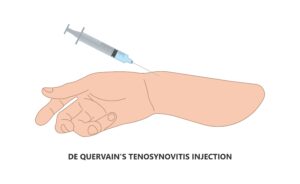
In cases where conservative treatments prove insufficient, surgical intervention may be considered. Dr Kirkham’s approach to surgical treatment involves a surgical release of the tendons under general anesthesia in a hospital setting. The procedure typically takes only around five minutes, and the results are often rapid, providing lasting relief. With Dr Kirkham’s expertise in hand and wrist surgery, you can expect to undergo a simple procedure that is carried out with great precision and care, working to restore your hand’s full functionality and range of motion.
Following surgical or non-surgical treatments, physical therapy and rehabilitation programs play a crucial role in optimising recovery. Dr Kirkham always emphasises the significance of a well-structured rehabilitation plan to aid in regaining strength, flexibility, and function of the hand and wrist. The therapy is tailored to each patient’s specific needs, helping them regain confidence and independence in their daily activities.
Dr Kirkham’s approach to treating De Quervain’s revolves around providing individualised treatment plans, considering the patient’s unique circumstances and goals. Whether recommending conservative measures, cortisone injections, or surgical release, he prioritises the patient’s comfort, goals, and long-term well-being. With his extensive experience and compassionate care, patients can rest assured that they are receiving the highest level of expertise in hand and wrist treatment.
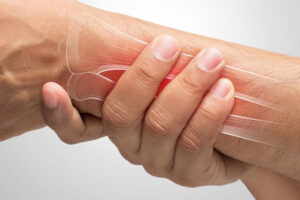
No matter the severity of your De Quervain’s, you can take comfort in knowing that Dr Kirkham is committed to delivering the most effective and appropriate treatment plan for your individual needs. From conservative approaches to advanced surgical techniques, your journey to lasting relief and restored hand function begins with a tailored treatment plan designed by a leading expert in the field.
Prevention and Aftercare
Preventing De Quervain’s involves adopting measures that reduce the risk of developing this condition, especially for individuals in at-risk populations. For those involved in activities that require repetitive thumb and wrist movements, such as musicians, gamers, or office workers, taking frequent breaks to rest and stretch the hand can help alleviate strain. Proper ergonomic setups, such as using an ergonomic keyboard or mouse, can also reduce the risk of overuse injuries. Maintaining good hand and wrist posture during activities and avoiding excessive force while gripping objects are essential preventative measures.
After undergoing treatment for De Quervain’s, the road to recovery doesn’t end there. Engaging in aftercare strategies is crucial for successful rehabilitation and long-term relief. Dr Kirkham always explains the significance of incorporating targeted exercises to strengthen the hand and wrist. These exercises are designed to improve flexibility, dexterity, and range of motion, facilitating a smooth return to everyday activities. Additionally, lifestyle changes may be recommended, such as modifying work tasks or recreational activities that triggered the condition.
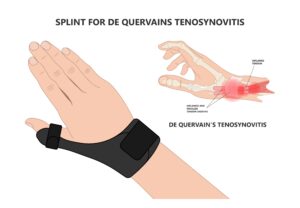
Adhering to aftercare recommendations is important in achieving a successful recovery. Following treatment, patients are advised to attend follow-up appointments to monitor their progress and address any concerns. Dr Kirkham and his team provide ongoing support and guidance throughout the healing process, ensuring patients remain on track towards optimal hand function and reduced risk of recurrence. By diligently following the aftercare plan, patients can actively contribute to their recovery and regain control of their lives, free from the limitations of De Quervain’s.
The Recovery Process
The recovery process after treatment for De Quervain’s typically involves several stages, and the timeline may vary based on the individual’s condition and the type of treatment received. In the initial stages, patients may experience some discomfort or soreness, but this gradually improves over time. Non-surgical treatments like rest, ice, and medication may provide positive results in a matter of weeks, allowing patients to gradually resume light activities.
For those who undergo cortisone injections or surgical release, the recovery timeline may extend to several weeks or even a few months. During this period, patients should expect a gradual improvement in hand function and a reduction in pain and inflammation. Physical therapy plays a vital role in the recovery process, with exercises designed to rebuild strength and flexibility in the hand and wrist.

Throughout the recovery period, it’s essential to avoid activities that may worsen the condition or hinder the healing process. Dr Kirkham advises patients to refrain from engaging in repetitive hand and wrist movements or any activities that cause pain or discomfort. Lifting heavy objects or participating in high-impact activities should also be avoided during the early stages of recovery. Compliance with these restrictions can significantly contribute to the success of the recovery process.
Ongoing medical support is crucial in ensuring proper recovery and long-term outcomes. Regular follow-up appointments with Dr Kirkham and his team allow for progress assessment and any necessary adjustments to the treatment plan. As the recovery progresses, he can provide additional guidance and exercises to facilitate a smooth return to normal activities. Dr Kirkham’s expertise and continuous support give patients the assurance that their recovery is closely monitored, ensuring that any issues are addressed promptly.
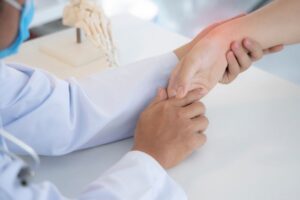
By understanding the typical recovery stages, avoiding detrimental activities, and maintaining close communication with the medical team, patients are more likely to enjoy a smooth recovery process and achieve a successful outcome. Dr Kirkham is dedicated to providing support throughout the recovery journey from start to finish, ensuring patients regain full functionality and enjoy a pain-free life once again.
Possible Complications
Untreated De Quervain’s can lead to various complications, affecting not only hand functionality but also your quality of life. As the condition progresses, the inflammation and irritation of the tendons may worsen, causing persistent pain and limiting thumb movement. Simple tasks like gripping objects, typing, or writing can become increasingly difficult and painful. In severe cases, chronic inflammation can lead to the formation of nodules or even tendon ruptures, further impairing hand function. If this De Quervain’s is left untreated, it can significantly impact an individual’s ability to perform daily activities and negatively affect their emotional well-being.
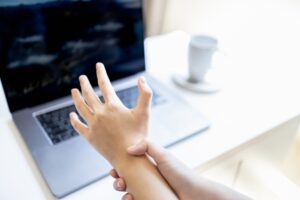
While surgical interventions for De Quervain’s are generally safe and effective, all medical procedures carry some potential risks and complications to consider. Complications from surgical release may include infection, nerve injury, or scarring. However, it’s essential to note that these risks are rare, and Dr Kirkham takes every precaution to minimise the likelihood of these issues. Dr Kirkham’s training, experience and care ensure the procedure is performed with precision, delivering pleasing results and a smooth recovery.
To minimise the risks associated with both untreated De Quervain’s and surgical interventions, it is crucial for patients to follow their medical advice diligently. Seeking early medical evaluation for De Quervain’s symptoms allows for timely intervention, reducing the likelihood of complications from the condition’s progression. Sticking closely to post-treatment instructions and physical therapy recommendations is also key to promoting a successful recovery and avoiding potential complications.
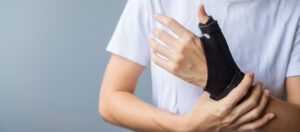
By placing your trust in Dr Kirkham, you can rest assured that your well-being is of the highest priority. Dr Kirkham’s approach to patient care involves open communication, informed decision-making, and personalised treatment plans, all geared towards minimising risks and achieving the best possible outcomes for the individual. Remember, early detection, prompt treatment, and attentive adherence to medical advice are essential in maximising the chances of a smooth and complication-free recovery.
Are You Concerned About De Quervain’s?
If you’ve been experiencing persistent wrist pain, swelling, or difficulty moving your thumb, don’t hesitate to seek Dr Kirkham’s expert opinion and care. De Quervain’s is a treatable condition, and early intervention can make a significant difference in your recovery journey. Taking the proactive step of consulting a Dr Kirkham can lead to a prompt and accurate diagnosis, setting you on the path to relief and improved hand function.
At the Sydney Orthopaedic Surgeon Clinic, you’ll find a committed and friendly team led by Dr Kirkham, a highly skilled and experienced orthopaedic surgeon with more than 25 years of expertise in treating hand and wrist conditions. Dr Kirkham’s commitment to providing individualised care and his advanced knowledge of De Quervain’s ensure that you’ll receive the best possible treatment plan tailored to your unique needs.
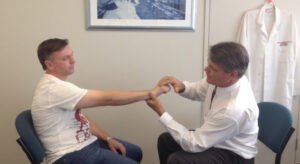
Don’t let De Quervain’s impede your daily activities or impact your quality of life. Take charge of your hand’s health and schedule a consultation with Dr Kirkham at one of five conveniently located clinics across the Sydney region, including a brand new Five Dock facility. Take the first step towards lasting relief and restored hand functionality. Call now or visit our website to book your appointment and rediscover the joy of pain-free movement.
FAQs
1. Can De Quervain’s occur suddenly, or does it develop gradually over time?
De Quervain’s can manifest both suddenly and gradually, depending on the individual’s activities and risk factors. Some people may experience a sudden onset of symptoms after engaging in repetitive thumb and wrist movements, while others may notice a gradual increase in pain and discomfort over time. It is essential to pay attention to any persistent wrist pain and seek medical evaluation if symptoms arise, as early detection can lead to more effective treatment outcomes.
2. Are there any non-surgical alternatives for treating De Quervain’s?
Yes, there are non-surgical options available for treating De Quervain’s. In less severe cases, conservative treatments like rest, icing, anti-inflammatory medications, and splinting can provide relief and promote healing. Additionally, cortisone injections in the affected area can be effective in reducing inflammation and managing pain. Dr Kirkham’s expertise in non-surgical interventions allows him to tailor treatment plans to suit each patient’s unique needs and preferences.
3. Can De Quervain’s recur after treatment?
In some cases, De Quervain’s can recur after treatment, especially if the underlying causes or risk factors are not addressed adequately. Following aftercare strategies, such as participating in physical therapy, avoiding repetitive movements, and making lifestyle modifications, can help minimise the risk of recurrence. Dr Kirkham’s individualised approach to treatment aims to not only provide relief but also reduce the chances of the condition returning.
4. How long does it take to recover fully after surgical intervention for De Quervain’s?
The recovery timeline after surgical intervention for De Quervain’s can vary based on the individual’s healing process and the extent of the condition. Generally, patients can expect to see improvements within the first few weeks after surgery, with a gradual return to normal activities over the subsequent months. Dr Kirkham closely monitors each of his patients during their recovery period, providing ongoing support and guidance to optimise healing and ensure the best possible outcome.
5. Can De Quervain’s be prevented through exercise and hand-strengthening techniques?
While exercise and hand-strengthening techniques can help improve hand function and flexibility, they may not entirely prevent De Quervain’s, especially in individuals with certain risk factors. However, incorporating hand exercises and maintaining good hand and wrist posture can help reduce the risk of overuse injuries and support overall hand health. Dr Kirkham’s personalised approach to patient care includes providing guidance on preventive measures to minimise the chances of developing hand and wrist conditions like De Quervain’s.
References
- Ortho Info (De Quervain’s Tenosynovitis)
- Mayo Clinic (De Quervain Tenosynovitis)
- Cleveland Clinic (De Quervain’s Tenosynovitis)
- American Society for Surgery of the Hand (De Quervain’s Tenosynovitis)


